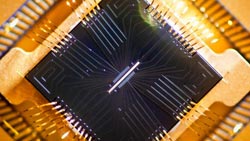The future of ion traps

Surface trap fabricated by Sandia National Labs, supported by IARPA. This type of trap has been used to capture ions at JQI and Duke University, as well as other institutions. The image shown here appears on the cover of this week's issue of Science Magazine. Credit and permissions, contact JQI<br>
Recently Science Magazine invited JQI fellow Chris Monroe and Duke Professor Jungsang Kim to speculate on ion trap technology as a scalable option for quantum information processing.
The article is highlighted on the cover of this week's issue, which is dedicated to quantum information. The cover portrays a photograph of a surface trap that was fabricated by Sandia National Labs and used to trap ions at JQI and Duke, among other laboratories.
Trapped atomic ions are a promising architecture that satisfies many of the critical requirements for constructing a quantum computer. At the heart of quantum computers are qubits, systems maintained in two or more quantum states simultaneously. Here, the qubits are manifested in the internal energy levels of the ions, and are manipulated through laser and microwave radiation. These technologies are a key factor in the success of atomic ions: scientists can set the frequency of the radiation to match that of the ion's energy level spacings with extreme precision.
The qubits have long coherence time — meaning they can be placed in quantum states and remain that way long enough to perform calculations. The qubit's states are not sensitive to ambient disturbances like magnetic fields, giving them inherent protection from the destructive environment.
Additionally, the ions are in a vacuum of lower than 10-11 torr. This is about 100 trillion times lower than atmospheric pressure. To visualize this daunting number, imagine light particles like hydrogen or nitrogen in a vacuum chamber. After special pumps remove most of the air, there are so few molecules left that before one molecule will collide with another, it will typically travel a distance comparable to the circumference of the earth. At atmospheric pressure, even though we can't see them with our eyes, there are so many molecules floating about that they only travel about a hundredth the width of a human hair before they bump into a neighboring particle.
Scientists want to go even further. Using cryogenics (cooling to near absolute zero temperature), they expect to push a few more factors of ten lower in pressure. Cooling the system is effective because it makes the molecules stick to the walls, thus removing them from the region where the ions rest.
Ion traps themselves were invented more than a half-century ago, but researchers have implemented new technologies in order to store large ion crystals and shuttle ions around as quantum operations are executed. Professionally micro-fabricated devices, like the one shown on the cover, resemble traditional computer components. Some researchers are also integrating optics on-board the traps. Although quantum logic operations in such chip traps remain elusive, the obstacles are not prohibitive. In the US, researchers at institutions such as NIST (Boulder), Sandia National Labs, Georgia Tech Research Institute, JQI, Duke, MIT, and others are now, often collaboratively, fabricating and testing these technologies.
Monroe and Kim are part of a larger collaboration called MUSIQC, which stands for Modular Universal Scalable Ion-trap Quantum Computer, and is supported by the Intelligence Advance Research Projects Activity (IARPA). This program focuses on building the components necessary for a practical quantum computer. The effort involves national labs, universities, and even private small businesses.
Media Contact
All latest news from the category: Physics and Astronomy
This area deals with the fundamental laws and building blocks of nature and how they interact, the properties and the behavior of matter, and research into space and time and their structures.
innovations-report provides in-depth reports and articles on subjects such as astrophysics, laser technologies, nuclear, quantum, particle and solid-state physics, nanotechnologies, planetary research and findings (Mars, Venus) and developments related to the Hubble Telescope.
Newest articles

Superradiant atoms could push the boundaries of how precisely time can be measured
Superradiant atoms can help us measure time more precisely than ever. In a new study, researchers from the University of Copenhagen present a new method for measuring the time interval,…

Ion thermoelectric conversion devices for near room temperature
The electrode sheet of the thermoelectric device consists of ionic hydrogel, which is sandwiched between the electrodes to form, and the Prussian blue on the electrode undergoes a redox reaction…

Zap Energy achieves 37-million-degree temperatures in a compact device
New publication reports record electron temperatures for a small-scale, sheared-flow-stabilized Z-pinch fusion device. In the nine decades since humans first produced fusion reactions, only a few fusion technologies have demonstrated…





















